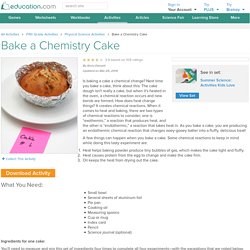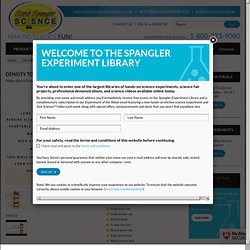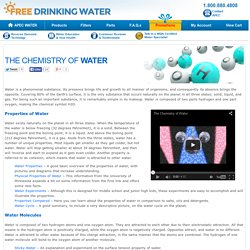

Chemistry of Baking - Is Baking a Cake a Chemical Change? Is baking a cake a chemical change?

Next time you bake a cake, think about this: The cake dough isn't really a cake, but when it's heated in the oven, a chemical reaction occurs and new bonds are formed. How does heat change things? It creates chemical reactions. When it comes to heat and baking, there are two types of chemical reactions to consider; one is “exothermic,” a reaction that produces heat, and the other is “endothermic,” a reaction that takes heat in. As you bake a cake, you are producing an endothermic chemical reaction that changes ooey-gooey batter into a fluffy, delicious treat! A few things can happen when you bake a cake. Heat helps baking powder produce tiny bubbles of gas, which makes the cake light and fluffy. What You Need: Small bowl Several sheets of aluminum foil Pie pan Cooking oil Measuring spoons Cup or mug Index card Pencil Science journal (optional) Ingredients for one cake: What You Do:
Physical-Chemical-Changes.pdf. Density Tower - Magic with Science. Start your column by pouring the honey into the cylinder.

Now, you will pour each liquid SLOWLY into the container, one at a time. It is very important to pour the liquids slowly and into the center of the cylinder. Make sure that the liquids do not touch the sides of the cylinder while you are pouring. It’s okay if the liquids mix a little as you are pouring. The layers will always even themselves out because of the varying densities. The same amount of two different liquids will have different weights because they have different masses. To test this, you might want to set up a scale and measure each of the liquids that you poured into your column.
Density is basically how much "stuff" is smashed into a particular area... or a comparison between an object's mass and volume. Chemists Know - (Parody of "Let It Go" from Frozen) - University of California Irvine. Water Twist. Fill a 1 liter bottle with water and screw on the cap.

Using a thumbtack, make 5 evenly spaced holes on the side of the bottle, near the bottom. Loosen the cap to release the water. Run your finger along the streams of water that are coming from the bottle. What happens each time you run your fingers through the streams? The force at work, when you run your finger through the streams of water, is called cohesion. Magic Milk Science Experiment - Laughing Kids Learn. The Chemistry of Water. Water is a phenomenal substance.

Its presence brings life and growth to all manner of organisms, and consequently its absence brings the opposite. Covering 80% of the Earth's surface, it is the only substance that occurs naturally on the planet in all three states; solid, liquid, and gas. For being such an important substance, it is remarkably simple in its makeup. Water is composed of two parts hydrogen and one part oxygen, making the chemical symbol H2O. Properties of Water Water exists naturally on the planet in all three states. Water Properties – A good basic overview of the properties of water, with pictures and diagrams that increase understanding. Water Molecules. Kids Safe Chemical Reactions Experiments Menu. Apple Science Experiment - The Homeschool Village.
Fall is the season for apples.

We love picking them, eating them and experimenting with them. Apple science experiments? Yes! Apples are great for showing oxidation in action. You know, when you slice apples into pieces and the cut sides turn brown? Oxidation Oxidation in apples takes place when oxygen reacts with an enzyme called polyphenoloxidase.
Oxidation happens in our bodies, as well. The Experiment Cut an apple in half. Crush 2-3 vitamin c tablets into powder. 5 Hands-On Experiments to Teach Kids About Chemical Reactions. What is Chemistry?

Chemistry can be defined as the study of matter and how that matter undergoes change. That is a pretty boring definition that leaves out all the fun and excitement that comes with studying chemistry. Chemistry is all around you; it explains baking and why an apple turns brown when cut open. Chemistry is the secret behind some magic tricks and colorful fireworks. So when you teach your students or children about chemistry move away from using textbooks, because this subject is best learned by observation and hands on experimentation. What is a Chemical Change? A chemical change is when 2 substances are mixed together to form something new. There is a formation of gas which can be seen by a fizzing or bubblingThe reaction will cause heat, light or odor to be emittedA color change is producedA solid is formed during the change. JitterbugsClassifyingChemicalReactions.